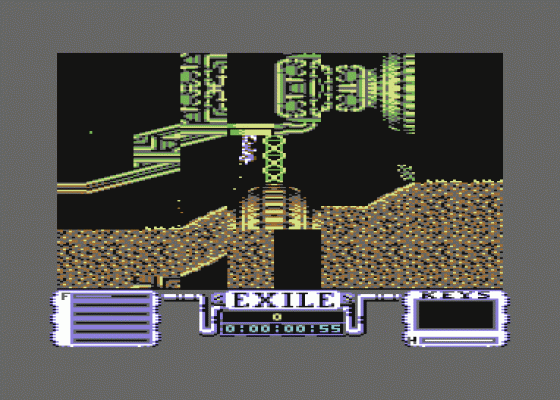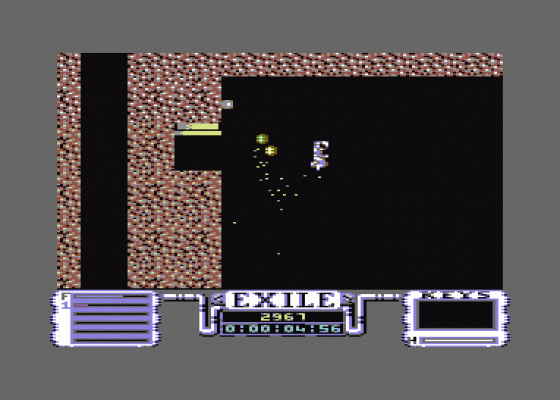
Commodore Format
 1st April 1991
1st April 1991
Categories: Preview: Software
Author: Gary Penn
Published in Commodore Format #7
Preview: Exile
Audiogenic are about to storm the software scene with a new arcade adventure. Our special correspondent Gary Penn talks to the authors, takes a close look at the game so far and discovers that there's more to their thrust than meets the eye
Look, let's not beat about the bush. Yes yes yes, this is indeed supposed to be a preview, but it just has to be said that Exile, from Audiogenic, is a right smashing bit of stuff and no mistake. It's been written By Peter Irvin and Jeremy Smith. Any C64 owners long enough in the tooth and with elephantine memories will recall that Jeremy Smith did Thrust for Firebird. Peter Irvin wrote a rather corking shoot-'em-up. called Starship Command on the BBC for Acornsoft, and then... He went to university and hasn't written anything since. Until now.
Exile's not really the sort of game you can drop into jar of formaldehyde, label and stick on a shelf to gather dust. Its got shooting. It's got puzzles. It's got a big map to explore. So it could be called the first true arcade adventure but that's the sort of cliche that would get Steve Jarratt's jowls hitting the floor at a few hundred miles per hour. One thing's for sure though: you will only appreciate how truly wonderful this game is if you play it. And when you play it, you won't get through it in a hurry. It takes the authors around six hours to play it through from beginning to end - and they know it inside out. The map weighs in at over a hefty 200 full screens in size. It difficult to say exactly how many puzzles there are to solve though, as most of the puzzles in Exile come about through the interaction of creatures and objects with each other. Let's just say there's way too much to see and do, and it's going to take ages to find out just how much there is to get your head around...

The playground, as it were, is the planet Pheobus. A quite seriously deranged scientist called Triax is performing some potentially universally catastrophic experiments in his laboratory deep below the planet's surface. Being of an heroic bent you are here to give him a bit of a slap. Pulling on your spacesuit and jetpack you prepare for adventure. Unfortunately, your previous act of derring do has left you weaponless. Worse still, Triax has just teleported into your ship and pinched a piece of vital equipment. Life's a bitch...
Pheobus is riddled with a maze-like network of caves and tunnels, the results of previous experiments wandering free, some of them with it, so to speak, and others completely out of it. Pieces of equipment such as guns for killing and other like items of interest are also scattered around.
Exile's character has to be one of the most versatile ever seen. Apart from being able to walk, run, jump and fly in pretty much any direction, he can pick things up, drop them and even throw them with a definable trajectory. This only goes part way to making Exile's environment feel so remarkably real though - "It's totally modelled on real life", says Peter. "But without the boring bits," says Peter. "But without the boring bits."

Every creature in Exile has its own level of intelligence and goes about its own business if you don't get in the way, so there's always something happening off-screen. Pheobus' inhabitants also have their own sounds for added realism. Birds squawk and wasps buzz - even friendly robots chatter to each other.
Moreover, every object and creature in Exile has its own mass, which makes the gravitational and inertial effects all the more realistic. When carrying a heavy object you walk more slowly and extra thrust is required to fly - and you can really feel. Lighter objects can be thrown further then heavier ones, and so on. Even the energy usage of devices is correctly calculated, though sensibly enough so that the playability isn't adversely affected.
Take the frogs for example. Take them to a flame and burn them, that's what we say. Or better still, take them to a monkey. The monkeys have pouches in which they store items they have stolen. They also like frogs and are quite prepared to exchange them for useful objects. Actually, the monkeys don't look much like their Earthly counterparts. Apparently when the Japanese saw the monkeys in Exile they went sparky, which is hardly surprising when you realise that monkeys are sacred in Japan.

The strangest of all the animals encountered in Exile is Fluffy. When you first meet this sickeningly cuddly creature you can't help but loathe it. Fluffy is extremely useful though and is best kept alive. Catching him isn't easy, for Fluffy has no interest in anything other than eating. When he's eating he's happy. He's easily frightened though, especially by loud noises. A quick burst of gunfire in his direction might not be as destructive as expected...
There are four main weapons waiting to be discovered. The first fires straightforward bullets. Further into the adventure you'll find a gun which unleashes explosive-tipped bullets, along with a couple of extremely powerful blasters which require considerable quantities of energy to fire them. Like most items in Exile, the weapons acquired during play have more potential than is obvious at first - you can actually use your firepower as a tool and shoot any sturdy and unreachable objects in order to move them.
Apart from the jetpack, there's another means of transport. Transporters dotted around the map break down anything which enters them into tiny particles and then reassemble them at adjoining transporters. This means not only can you teleport yourself but also any items - including projectiles!

But the smart hero about town uses personal teleportation to go from A to B. A flick of a switch teleports you back to the last position you 'marked' on the map. Don't worry if you forget it - the default position of the four available markers beams you to the safety of your spaceship.
Self-teleporting has many uses. For example, you could be getting some stick from a creature which keeps you pushing you away. Remembering your position before it pushes you back then allowing yourself to be pushed away means when you teleport you are taken behind it! Now is that neat or what?
In Exile you never actually die. Instead, whenever your energy gets too low you are automatically teleported to the last marked position, which gives you the opportunity to recover. You can also save your progress to RAM, cassette or disk.

The Irvin-Smith partnership has been in existence for years as a friendship. The Exile collaboration came about when the duo decided to "write a game from scratch, which we did on the BBC. Then we converted it to the C64. It started off basically with just the concept of some spaceman flying around and having collisions with real forces and creatures bouncing off each other. And we designed the game around it," Peter reveals.
Every aspect of Exile was the result of teamwork. "We worked on different routines, then swapped them over and changed them and it evolved from there. The big problem with Exile was we had to fit it into the basic BBC. It evolved very slowly. It's one of those games which, having written it, if you were to write it again, you could recreate it an awful lot faster."
Exile is complete as far as gameplay and sound is concerned. All that remains is for Audiogenic to replace the graphics you see here with some perkier pixel arrangements from artist Herman Serrano.
A price and firm release date have yet to be confirmed, but Exile is likely to appear sometime around the end of April. And there's a full review only in the next issue of Commodore Format...
This article was converted to a web page from the following pages of Commodore Format #7.






